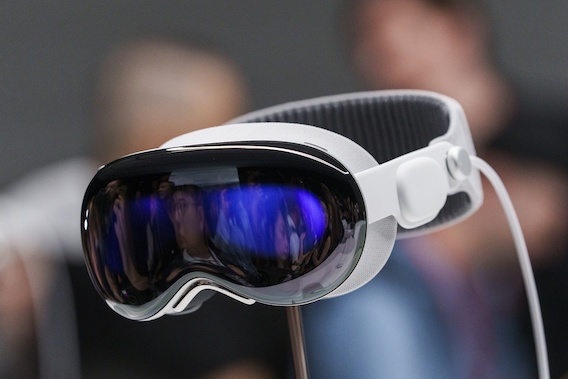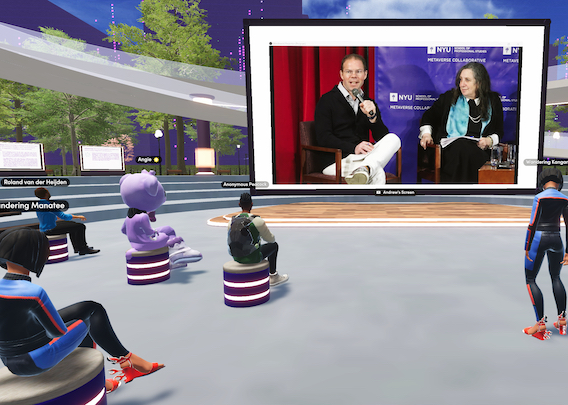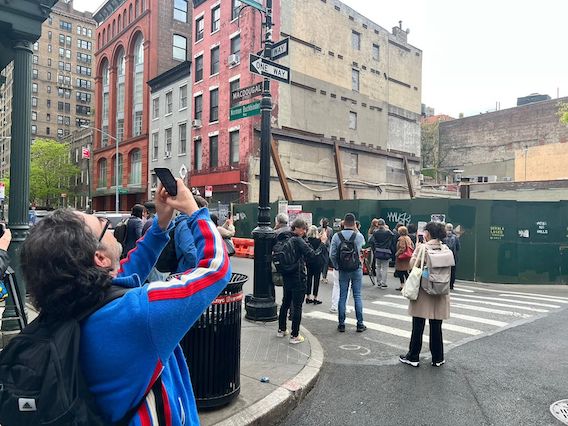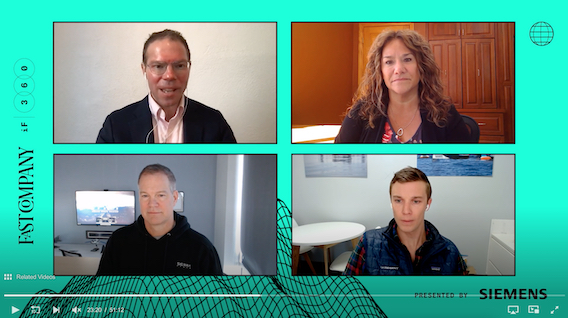














June 27, 2023 | permalink
La Conference de Montréal — an arm of the International Economic Forum of the Americas — invited me to join a discussion on “The Digitalisation of Urban Management” with Helpful Places’ Jacqueline Lu, the Shared-Use Mobility Center’s Benjamin de la Peña and the Urban Resilience and Innovation Institute’s François William Croteau, hosted by The Globe and Mail’s architecture critic Alex Bozikovic. Video from the session is above; here’s the official description (which we didn’t always stick to):
The future of urban planning and development is here, and the increase in leveraging emerging technologies for improved decision-making in urban ecosystems brings an array of benefits that will enable us to better tackle the imperatives of our time, but crucial emerging issues are yet to be answered. What is the general outlook on the state of smart cities globally today? Which key areas of urban planning and development can benefit from these technologies and which solutions do they provide to modern urban needs? What foreseeable risks should be kept top of mind and which labour segments will be disrupted as a result of these technologies?
June 12, 2023 | permalink

(Originally published by Bloomberg Citylab on June 12, 2023.)
When Pokémon Go streaked across the cultural landscape in 2016, briefly becoming the fastest-downloaded app in history, thousands of players stampeded through parks, trespassed en masse, and may have injured nearly 30,000 people due to distracted driving in the game’s first five months alone.
It’s a particularly stark example of what cities could face if Apple’s forthcoming augmented reality (AR) headset, the Vision Pro, becomes as popular as the Apple Watch, let alone as ubiquitous as the iPhone. Although the jury is still out until “early next year” on the public’s appetite for a $3,499 pair of goggles, Apple’s insistence that it’s meant to be worn in the world around other people means it’s time for cities to finally sit up and pay attention to the small-m metaverse.
While Apple may have shouldered its way to the forefront of AR — which Cook has extolled for years — it is hardly alone. Google, Snap, and others have all recently made strides in fusing the real and virtual worlds. Without the means to monitor and intervene in these new dimensions, cities risk companies and creators running roughshod over the public realm. Just last month, for example, Google unveiled its “Geospatial Creator” tool enabling anyone to anchor digital content to real-world locations, such as Google’s own virtual takeover of Times Square by the band Gorillaz in December.
Niantic, the maker of Pokémon Go, is now building its own “visual positioning system” (VPS) — what amounts to a proprietary virtual GPS overlaid on cities, mapped down to the centimeter — to compete with Google’s and others. This not only raises the prospect of overlapping, incompatible realities owned by various tech companies, but also thorny issues around speech and property rights. What’s to stop someone from geolocating an obscene AR billboard outside a competing storefront, for instance?
Will the Vision Pro be AR’s “iPhone moment?” Perhaps, if you recall the original iPhone’s then-exorbitant price tag and lack of an app store at launch. It took years for startups to harness smartphones’ potential to connect and transact with physical spaces and assets, producing platforms like Uber and Airbnb. More than a decade later, cities are still grappling with how to rein in and regulate these disruptors retroactively.
Now Apple and its rivals aim to go a step further by overwriting reality itself, raising a whole new host of problems. How can cities avoid repeating those mistakes in the real-world metaverse? What recourse do cities have when faced with immaterial interlopers who nonetheless have corporate consequences?
Prior efforts to confront another once-impending technological threat — autonomous vehicles — may prove instructive. In 2018, the Los Angeles Department of Transportation commissioned its own software standard, the Mobility Data Specification, for sending and receiving information from fleets of private vehicles (although ultimately scooters instead of AVs). While some players welcomed real-time regulation, others resisted its granular data collection. While LADOT ultimately prevailed against legal challenges, a subsequent effort to convince Apple, Google, Waze and others to re-route driving instructions within their apps was politely rebuffed. It’s hard to imagine the same firms giving cities carte blanche to edit their VPS.
It’s still early in the metaverse, however — no killer app has yet emerged, and the financial returns on disruption are falling as interest rates rise.
Already, a handful of companies have come forward to partner with cities instead of fighting them. For example, InCitu uses AR to visualize the building envelopes of planned projects in New York City, Buffalo, and beyond in hopes of winning over skeptical communities through seeing-is-believing. The startup recently partnered with Washington, DC’s Department of Buildings to aid its civic engagement efforts. Another of its partners is Snap, the Gen Z social media giant currently currying favor with cities and civic institutions as it pivots to AR for its next act.
There’s certainly an argument that augmented reality could be a boon for big cities, enriching and attracting foot traffic to iconic locations weakened by remote work. “I think we’ll see a growing digital divide between cities that embrace AR and those that thwart it,” said Jonathan Askin, director of the Brooklyn Law Incubator & Policy Clinic, who has studied the legal issues stemming from AR. “With governments suffering lost tax revenue from diminished retail and commercial real estate activity, cities and property owners could benefit from smart deployments of games, cultural experiences or even just new advertising opportunities.”
“The only real issue for cities,” he adds, “is how to ensure that use of AR applications does not threaten public safety while enhancing the urban living experience.” And therein lies the rub.
For cities to gain the metaverse they want tomorrow, they will need to invest the scarce staff time and resources today. That means building a coalition of the willing among Apple, Google, Niantic, Snap and others; throwing their weight behind open standards through participation in umbrella groups such as the Metaverse Standards Forum; and becoming early, active participants in each of the major platforms in order to steer traffic toward designated testbeds and away from highly trafficked areas.
It’s a tall order for cities grappling with a pandemic crisis, drug-and-mental-health crisis, and climate crisis all at once, but a necessary one to prevent the metaverse (of all things!) from becoming the next one.
June 05, 2023 | permalink
Last week in Silicon Valley, I was honored to curate and host the only session of the world’s pre-eminent metaverse conference, Augmented World Expo. There, I was joined by inCitu CEO Dana Chermesh, Snap public policy manager Jasson Crockett, and former Washington D.C. Department of Buildings chief Ernest Chrappah to discuss how augmented reality might transform cities… in a good way. Watch the video above; here’s the session description:
As American cities struggle to build housing, improve transit, and otherwise convince a skeptical public that change is good - and necessary! How can AR help win over their critics? This panel will bring together a startup (inCitu) and platform (Snap) engaging the public at massive scale through offering passerby a glimpse of new projects in their actual context. They’ll be joined by a city official to discuss the potential of AR to deliver services, fast-track development, and re-imagine our relationship with the built environment at large.
May 23, 2023 | permalink

I recently hosted the third and final installment in Fast Company’s Webinar series on the “industrial metaverse” hosted in partnership with Siemens. Titled “Talent for Innovation: The New Skills and Roles Transforming Manufacturing,” I first spoke with Siemens USA president and CEO author Barbara Humpton before ushering MIT’s T.L. Taylor and Mike Molnar, director of the Advanced Manufacturing Office at the National Institute of Standards and Technology onto the virtual stage. From the description:
With more than 800,000 open positions across U.S. manufacturing, new technologies like the industrial metaverse present an opportunity both to lower barriers of entry and inspire a new generation of workers to work in manufacturing. Fast Company and Siemens will bring together senior business leaders to highlight the efforts and opportunities to address talent recruitment needs to remain globally competitive and share how new design, gaming and user experience roles are transforming the perspective on industrial career paths.
May 10, 2023 | permalink
Never has there been a more important time to think in new ways, to innovate, to go first… to pioneer. But with so much information, choices, technologies, platforms and channels available, it’s hard to know where to focus.
That’s why DEPT® is bringing together experts in emerging technologies (think AI/ML), emerging media platforms (we’re looking at you, TikTok) along with the most creative marketers in the game to help you pioneer the future of digital experiences for your brand.
During this two-hour virtual event, you’ll hear from industry leaders such as Mutale Nkonde, AI policy advisor and founder and CEO at AI for the People, and executives from Hootsuite, Rad Power Bikes, Prisoner Wine Company, Moet Hennessy, Forrester and more.
May 08, 2023 | permalink
Why are airports recently getting makeovers? How are airports and airlines prioritizing the customer to reduce the typically stressful travel experience and create more seamless and enjoyable journeys? What role do different airlines play in enticing travelers to use airport services? And how can technology optimize the travel time and experience within the airport?
I had the pleasure of moderating this CoMotion Miami preview with Teague technical director Warren Schram and Alaska Airlines’ director of airport lobby transformation Amber Simonsen on the post-pandemic, post-9/11 air travel experience, which has arrived at long last. Watch above.
April 30, 2023 | permalink

The inaugural Metaverse & Cities Summit is a wrap! It was a thrilling two days of discussion, debate, networking, walking tours — courtesy of our partners at inCitu — and even drinks on a boat (courtesy of our Dutch partners’ Kingsday celebration).
I want to thank everyone who joined us, including NYU SPS Dean Angie Kamath; inCitu’s Dana Chermesh-Reshef, Ziv Schneider, Tyce Herrman, and Nick Kaufmann; Living Cities’ Dennis Crowley; Smart Columbus’ Jordan Davis; Washington DC’s Ernest Chrappah; Sidewalk Infrastructure Partners’ David Gilford; my Jacobs Urban Tech Hub colleagues Nneka Sobers and Anthony Townsend; and so many more.
But I want to especially thank my co-hosts, the Sharing Cities Alliance’ Harmen van Sprang, and Elizabeth Haas — newly installed as the inaugural director of the NYU SPS Metaverse Collaborative! Here’s to many more collaborations in the future.
If you’re reading this and feeling metaverse FOMO, never fear. inCitu is hosting an augmented reality Janes Walk scavenger hunt on May 6, and The Metaverse Metropolis returns with more public events June and July. Hit me up if you’d like to join us.

April 29, 2023 | permalink
On the eve of the inaugural Metaverse & Cities Summit, my friends and partners at Open House New York hosted a curtain-raiser of sorts on Zoom. Featuring a trio of current- and former public officials from New York City and Washington D.C., the session dwelled on such fundamental questions as what is the metaverse good for? And what should cities do with it? To answer those questions, watch the video above — or at least read the description below:
The Metaverse is no longer solely the realm of the tech sector. Cities across the country are busy exploring how virtual worlds and augmented landscapes offer opportunities to enhance public life, deliver services, and engage residents. Join Open House New York, the Jacobs Urban Tech Hub at Cornell Tech, and the NYU School of Professional Studies Metaverse Collaborative for a dynamic panel discussion spotlighting how new technologies are being leveraged to reshape the ways we interact with the built environment. Moderated by Jacobs Urban Tech Fellow Greg Lindsay, this conversation features Ernest Chrappah, Acting Director of the Washington DC Department of Buildings, David Gilford, Head of Policy & Strategic Partnerships at Sidewalk Infrastructure Partners, and Daria Siegel, Vice President of Special Initiatives at NYC Economic Development Corporation discussing how cities are incorporating new virtual technologies to enhance public services, and how they can work with the private sector to improve them.
April 28, 2023 | permalink

I recently hosted the second installment in Fast Company’s Webinar series on the “industrial metaverse” hosted in partnership with Siemens. Titled “Scaling Transformation: How to Take the Innovation Beyond the Pilot Stage,” I first spoke with Platform Revolution author Marshall Van Alstyne before ushering Siemens’ Brenda Discher, Sierra Space Company’s Jeff Babione, and REGENT’s Mike Klinker onto the virtual stage. From the description:
Digital transformation is now a foundational part of every company’s strategic planning and its impact is being felt from R&D labs to the industrial floor. As cloud-based technologies like digital twin platforms become part of the framework for the future of industry, it is becoming increasingly vital to adapt workflows so organizations can scale their innovations faster with less financial risk. In this thought-provoking panel discussion, Fast Company and Siemens will convene a key group of business and technology leaders to discuss best practices for small and medium businesses to implement their digital transformation investments and key insights on how it applies to rolling out new products.
Watch the whole thing here. (And please pardon my skiing-induced second-degree sunburn.)
April 27, 2023 | permalink

(Published in Bloomberg CityLab on April 25, 2023.)
By Lev Kushner and Greg Lindsay
For years, cities, states and regions have been competing to lure corporate headquarters and offices, an arms race of ever-higher tax breaks and infrastructure projects cobbled together to benefit corporate executives and their shareholders. The spectacle of hundreds of American communities bidding against each other for Amazon’s now-paused HQ2 was both the pinnacle and nadir of this genre. But the remote revolution is upending this traditional model of economic development. The last two years of pandemic have accelerated previous trends, shining a spotlight on an alternative to the corporate sweepstakes, one in which cities chase the workers themselves.
With many Americans newly willing to relocate and remote work vastly expanding the playing field of potential locations, smaller cities and regions need to be ready to capture their share of this windfall of migratory talent. While some of tomorrow’s destinations patiently wait for their turn in the sun, others have resorted to gimmicks — such as a $10,000 bonus, or $10,000 and a mountain bicycle, or $10,000 in Bitcoin — with less-than-stellar results.
Even the original and most successful of these programs, Tulsa Remote, has settled only 2,000 new arrivals since 2018, or roughly 0.2% of metro Tulsa’s population. That shouldn’t be surprising; these are relatively small-budget affairs. Many of these pandemic-era programs launched by cities ranging from Savannah to Helsinki used little more than mothballed travel budgets to seed their fledgling efforts. And even more mature efforts such as those in Tulsa or Northwest Arkansas (Bentonville and Fayetteville) still rely on philanthropic rather than public funding. Approaches such as these are forward-thinking but not scalable.
Simultaneously, and in parallel, tourism departments are struggling to respond to a changing world of tourism. While tourism agencies’ historic target audience has been three-day weekend visitors, remote work and the rise of digital nomads means that stays are increasingly in the 30-day range. According to Deloitte’s 2023 Travel Outlook, travelers willing to bring work with them take twice as many trips and, of those “laptop luggers,” more than a third are adding three or more days to their vacation to accommodate working remotely while traveling. Airbnb reported in May 2022 that long-term stays of more than 28 days were their fastest-growing category by trip length compared to 2019, more than doubling in size from Q1 2019. And United Airlines CEO Scott Kirby has declared a “permanent structural change” in the industry as business and leisure travel have become indistinguishable.
These two developments — a growing, restless class of remote workers, and a tourism market of people who spend more of their time traveling — are more than related; they’re different facets of the same phenomenon. The line between remote workers and tourists is blurring, and communities big and small need to think strategically about how to position themselves to take advantage of this changing landscape.
The New Talent Attraction Landscape
When cities try to lure or retain companies, they play a B2B game. When they adjust their strategy to try and court a highly mobile class of talented workers, the model shifts to B2C. And that transformation requires a change both in how city agencies are structured and in their culture.
The simplest transformation would be combining economic development and tourism offices into something customer- and resident-focused. Call it the Department of Hospitality. Ohio is already inching in this direction, with a proposal to rename TourismOhio as the State Marketing Office and expand its mission to attract residents, students and workers — in addition to tourists.
Whether it’s renaming agencies or merging them, the transformation entails a new way of doing business. Any new department would shift from the high-upside, low-volume business of luring corporate headquarters to the low-margin, high-volume approach of direct sales. This may entail shifts to the make-up of staff, messaging and strategy. And it will mean broadening the customer-facing programs to transform first-time buyers (visitors) into loyal customers (residents).
Whether this entails connecting newcomers with reliable Wi-Fi and work spaces, familiarizing short-term tourists with housing options and family amenities, or merely keeping track of and welcoming new transplants to help them assimilate and feel supported over time, the work is critical. In a world where there are now hundreds of competing cities chasing the same residents/customers, the cities that figure out how to make their visitors’ and residents’ lives easier are going to have a massive competitive advantage.
To achieve this, cities will have to train their employees for a new era of increasingly important customer service. This would be a sea change for the vast majority of cities, and culture change at municipal agencies is notoriously difficult.
Whether these new offerings are gathered under the umbrella of merged economic development and tourism agencies or, less effectively but more feasibly, a well-choreographed coordination between the two as standalone agencies, this culture change will have to infuse their programs, combining economic development agencies’ ability to expedite city processes and tourism departments’ expertise in marketing.
This effort will require employees of a sort not normally associated with the public sector: people who act as point-of-contact assistance for new and recent arrivals. Imagine one part hotel concierge, one part HR onboarding expert, and one part university student life expert who has experience welcoming and orienting a constant wave of new residents.
A smattering of examples exist in the field.
Evan Hock launched MakeMyMove as a one-stop shop for Indiana communities, but today his site boasts more than 150 destinations across the US. One is Greater Lafayette, Indiana, which offers arrivals a $10,000 incentives package, including relocation costs and work space on campus at Purdue University — the first partnership of its kind. “A lot of what we’re doing now is helping communities set up this kind of infrastructure and then obtain funding to keep it going,” Hock says. To that end, Indiana’s legislature amended the state’s tax credit toolkit last year authorizing municipalities to use government funds on these kinds of programs.
A few states away, the Greater Topeka Partnership has lured 99 workers from over 25 states to date with its own $10,000 incentives program. But the small program has contended with the challenges of connecting participants to the right amenities, according to Bob Ross, the partnership’s senior vice president of marketing and communications. One participant dropped out due to a lack of coworking spaces; another ended up in a broadband dead zone and had to relocate — unforced errors that might have been avoided by a more comprehensive citywide strategy. “We’ve ended up doing a lot of that lift ourselves, which is probably a little beyond our bandwidth,” Ross says. “Cities are going to have to find ways to answer those questions more efficiently.”
Incremental Change
For most city agencies, change will come slowly. A more practical question may then be, what do incremental steps look like and how can they be achieved?
Cassandra Costello, executive vice president and chief policy and external affairs officer at the San Francisco Travel Association, has operated in this interstitial space for years. Her position was designed specifically to liaise between economic development and tourism — a rarity in the industry — but it provides her a wide-angle view on how the changing landscape affects the day-to-day operation of government.
Pre-pandemic, tourism was solidly San Francisco’s number one industry, growing for ten straight years and drawing nearly 26 million visitors who spent over $10 billion annually. After Covid brought this growth to an immediate halt, “tourism was no longer taken for granted, but instead, proved to be an industry that you had to work for to be able to compete on a global scale for visitation,” says Costello.
This challenging environment puts it on par with other corporate attraction efforts. And with Costello’s perch on committees within the planning, parks, and economic development agencies, she is increasingly able to give a voice to tourists within the city’s economic development machinery. Having someone from SF Travel add their voice to land use and economic development issues gives more context to complex political decisions, often bringing a broader, even global perspective to issues that can feel hyper-local.
Costello’s work shows that, as the line between short-stay tourists and residents blurs, improved resident amenities are going to be even more important to economic development than they were in the past — to the benefit of both new residents and old. “What is good for the visitor is great for the employee, resident and for business attraction,” she says. “Tourism can also help to bring people to downtown core areas seeing less foot traffic due to work from home policies.”
As an economic development strategy, talent attraction is not going away. And neither, clearly, is remote work. Small and midsize American cities, traditionally muscled out of the business attraction game, have been quick to seize on this transformation. Larger cities, even the heavyweights with legacy business clusters and resilient brands, are slowly pivoting their attention to this new way of doing business. A more consumer-oriented approach will improve the quality of service for all residents, regardless of how often they move, by making them feel more taken care of and more welcome. What’s good for the guest is good for the host, especially when the guest might never leave.
Lev Kushner is the founder of Department of Here, a strategic communications and economic development consultancy.
Greg Lindsay is an urban tech fellow at the Jacobs Urban Tech Hub at Cornell Tech.

» Folllow me on Twitter.
» Email me.
» See upcoming events.

Greg Lindsay is a generalist, urbanist, futurist, and speaker. He is a non-resident senior fellow of the Arizona State University Threatcasting Lab, a non-resident senior fellow of MIT’s Future Urban Collectives Lab, and a non-resident senior fellow of the Atlantic Council’s Scowcroft Strategy Initiative. He was the founding chief communications officer of Climate Alpha and remains a senior advisor. Previously, he was an urban tech fellow at Cornell Tech’s Jacobs Institute, where he explored the implications of AI and augmented reality at urban scale.

----- | January 22, 2024
The Future of Generative AI in Architecture, Engineering, and Construction
----- | January 1, 2024
----- | August 3, 2023
CityLab | June 12, 2023
Augmented Reality Is Coming for Cities
CityLab | April 25, 2023
The Line Is Blurring Between Remote Workers and Tourists
CityLab | December 7, 2021
The Dark Side of 15-Minute Grocery Delivery
Fast Company | June 2021
Why the Great Lakes need to be the center of our climate strategy
Fast Company | March 2020
How to design a smart city that’s built on empowerment–not corporate surveillance
URBAN-X | December 2019
CityLab | December 10, 2018
The State of Play: Connected Mobility in San Francisco, Boston, and Detroit
Harvard Business Review | September 24, 2018
Why Companies Are Creating Their Own Coworking Spaces
CityLab | July 2018
The State of Play: Connected Mobility + U.S. Cities
Medium | May 1, 2017
Fast Company | January 19, 2017
The Collaboration Software That’s Rejuvenating The Young Global Leaders Of Davos
The Guardian | January 13, 2017
What If Uber Kills Public Transport Instead of Cars
Backchannel | January 4, 2017
The Office of the Future Is… an Office
New Cities Foundation | October 2016
Now Arriving: A Connected Mobility Roadmap for Public Transport
Inc. | October 2016
Why Every Business Should Start in a Co-Working Space
Popular Mechanics | May 11, 2016
Can the World’s Worst Traffic Problem Be Solved?
The New Republic | January/February 2016

January 31, 2024
Unfrozen: Domo Arigatou, “Mike 2.0”
January 22, 2024
The Future of Generative AI in Architecture, Engineering, and Construction
January 18, 2024
The Promise and Perils of the Augmented City
January 13, 2024